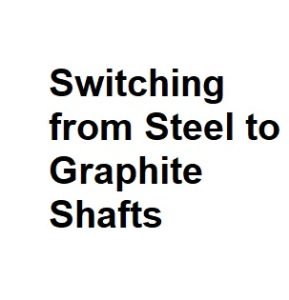Golf is a game that requires precision, accuracy, and skill. One of the key components of a golfer’s equipment is the golf club, and specifically, the shaft of the club. In recent years, there has been a growing trend towards switching from traditional steel shafts to lightweight graphite shafts. In this article, we will explore the pros and cons of switching from steel to graphite shafts in golf.
Pros of Graphite Shafts:
- Lightweight: Graphite shafts are significantly lighter than steel shafts, making them easier to swing and generate clubhead speed. This can result in greater distance on shots and less fatigue for the golfer.
- Reduced Vibration: Graphite shafts are known for their ability to dampen vibrations, resulting in a smoother feel and less shock to the hands and arms during impact.
- More Forgiving: The flexibility of graphite shafts can make them more forgiving on mishits, reducing the likelihood of slicing or hooking the ball.
- Customizable: Graphite shafts can be customized to meet the individual needs of a golfer, allowing for different flex options, weights, and lengths.
- Increased Swing Speed – Graphite shafts are lighter than steel shafts, which can increase your clubhead speed and allow you to hit the ball farther. This can be especially beneficial for golfers who struggle with distance off the tee.
- Reduced Vibrations – Graphite shafts have a dampening effect that can reduce the vibrations felt in your hands and arms upon impact. This can be beneficial for golfers who suffer from joint pain or have a history of injuries.
- Customization – Graphite shafts come in a wide variety of flexes, weights, and lengths, allowing for more customization in your club fitting. This can help golfers find the perfect combination of clubhead speed, ball flight, and accuracy.
- Consistency – Graphite shafts tend to have more consistent flex and torque values than steel shafts. This can help golfers maintain a more consistent ball flight, especially on off-center hits.
Cons of Graphite Shafts:
- Cost: Graphite shafts are generally more expensive than steel shafts, which can be a deterrent for some golfers.
- Durability: While graphite shafts have improved in durability in recent years, they are still more prone to damage than steel shafts, especially from bag chatter or accidental impact.
- Feel: Some golfers prefer the feel of a steel shaft, which can provide a more solid and consistent feedback on impact.
- Control: Golfers may experience less control over their shots with graphite shafts, as the lighter weight can result in a loss of precision and accuracy.
Golf Club Manufacturers
| Manufacturer | Steel Shaft Options | Graphite Shaft Options | Average Price Range (USD) | Notable Features |
|---|---|---|---|---|
| Titleist | Yes | Yes | $150-$350 | Customizable options |
| Callaway | Yes | Yes | $100-$400 | Wide range of flex options |
| TaylorMade | Yes | Yes | $150-$400 | High launch and low spin options |
| Ping | Yes | Yes | $100-$400 | Wide range of weight options |
| Cobra | Yes | Yes | $100-$300 | Variety of colors available |
Popular Graphite Shafts
| Shaft | Weight (grams) | Torque | Flex Options | Notable Features |
|---|---|---|---|---|
| Fujikura Ventus Blue | 68-86 | 3.4-5.5 | R, S, X | Low torque for increased stability |
| Project X HZRDUS Smoke Black | 60-80 | 2.9-6.0 | 5.5-7.5 | Designed for low spin and high launch |
| Mitsubishi Tensei CK Pro Orange | 60-80 | 2.9-4.4 | R, S, X | Mid-launch and low spin |
| Aldila Rogue Silver | 60-80 | 3.0-4.0 | R, S, X | High-performance material for increased stability |
| UST Mamiya Elements Chrome | 55-80 | 2.8-4.2 | R, S, X | Unique chrome finish for aesthetics |
Performance Comparisons
| Metric | Steel Shaft | Graphite Shaft |
|---|---|---|
| Distance | Slightly shorter | Slightly longer |
| Accuracy | Slightly more accurate | Slightly less accurate |
| Spin | Higher spin rate | Lower spin rate |
| Launch | Lower launch angle | Higher launch angle |
| Vibration | More vibration | Less vibration |
Swing Characteristics
| Characteristic | Steel Shaft | Graphite Shaft |
|---|---|---|
| Swing speed | Faster swing speed required | Slower swing speed required |
| Swing tempo | Requires a more aggressive swing | More forgiving for slower swings |
| Swing path | More difficult to square the face | Easier to square the face |
| Swing feel | Heavier and stiffer | Lighter and more flexible |
Player Preferences
| Factor | Steel Shaft | Graphite Shaft |
|---|---|---|
| Feel | More traditional and solid | More modern and responsive |
| Weight | Heavier and more substantial | Lighter and easier to swing |
| Flexibility | Less flexible and more rigid | More flexible and forgiving |
| Cost | Typically less expensive | Typically more expensive |
| Appearance | Classic and simple | Modern and eye-catching |
Conclusion:
The decision to switch from steel to graphite shafts in golf ultimately depends on the individual golfer’s preferences and needs. While graphite shafts offer benefits such as lighter weight, reduced vibration, and more forgiveness, they also come with drawbacks such as higher cost and reduced control. It is important for golfers to experiment with different types of shafts and seek advice from professionals to determine which type of shaft is best suited for their game.


